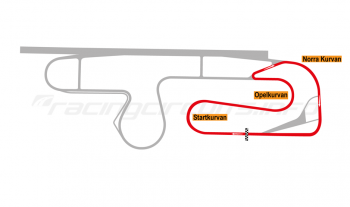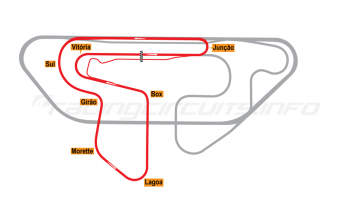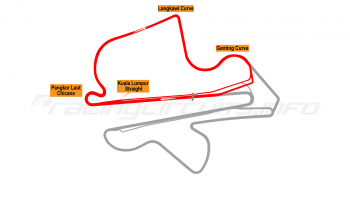Greenwood Roadway
Circuit Overview
Once lauded as the finest sports car course in all of North America, Greenwood Roadway had an astonishingly short lifespan, amounting to to just over four seasons before going bust.
Hampered by its middle-of-nowhere location and a less-than-stellar business plan, the track was hugely demanding for drivers and riders but less thrilling for spectators, for whom road racing was a relatively new spectacle.
After its demise, the track was left for nature to claim. Today a broken ribbon of asphalt remains, part of a site used for training plant equipment operators.
Circuit History
The boom in interest in sportscar racing in the immediate post-war years of the 1940s and ‘50s in America saw road racing hit its highest popularity. With demand for somewhere for returning GIs to race their MGs , Jaguars and Corvettes, a bunch of new road courses sprang up around the country. Among them was Greenwood Roadway, south east of the town of Indianola in real Iowa.
A bunch of enthusiast and local investors got together to plan the course in the early 1960s. Tired of having to hit the road and travel hundreds of miles to race, they wanted to create their own venue to enjoy the sport. Greenwood Roadway Inc. was founded to raise funds to make the dream a reality, with paper stock bonds issued to numerous small investors as well as larger donors.
And the dream was big. Greenwood Roadway was not just to be a venue for sportscar racing, it was to be the premier road racing circuit in the country, complete with facilities to suit. Hotels and restaurants would help counter the fact that the track was to be built, essentially, in the middle of nowhere.
Evidently the pitch was persuasive enough to attract a number of prominent backers including James Kimberly, president of the Kimberly-Clark Corporation, (the manufacturers of Kleenex). A keen motorsport enthusiast, Kimberley was a former SCCA President and was among the speakers at an event in Indianola in January 1963, aimed at drumming up further support from local businesses.
Funds raised were sufficient to begin construction later that year, with the circuit constructed reportedly for a total cost of $300,000. It’s official opening took place on 1 June 1963, with the course completed a week ahead of its inaugural race. That said, ‘completed’ really only referenced the circuit itself - the supposed hotels and restaurants were nowhere to be seen and in fact spectator amenities were rather lacking.
Nevertheless, the course probably did live up to its billing as the finest road racing course in the USA. Its layout proved a hugely challenging drive, complete with banked corners, large changes in elevation and an uncompromising attitude to safety, with guardrails right at the edge of most corners.
Indeed, later marketing posters by the track boasted that the SCCA had advised that a planned racing school should be cancelled, as the track was too tough for noice drivers to tame…
First event draws a crowd
The inaugural event on June 8, 1963, got off to a slightly faltering start when a breakdown in telephone communications caused the abandonment of morning practice and an hour’s delay in the start of the races. However, the 3,114 paying spectators did get to see the action unfold in the afternoon as drivers competed for the first time.
Gordon Stewart of Sioux Falls, South Dakota won the opening race in his O.S.C.A. Maserati, which also placed first in class H. Richard Anderson of Overland Park, Kansas, won the second race in his Class F production Lotus-Ford 7A against a hot field limited largely to production cars. He averaged 69.68 miles for his five laps. Speeds picked up considerably for the final races of the day. R. E. L. Hayes of Vinita, Oklahoma wheeled his A.C. Cobra powered by a 260-Fairlane Ford to victory in the third race, at an average of 74.48 m.p.h.
James Scott averaged 77.612 miles per hour to win the closing 15-mile feature race in a Lotus 23B, pulling away in the final stages from the Corvette of Dick Doane.
The following day’s races - run as SCCA Regionals - drew a bigger crowd, estimated at just over 10,000 paying spectators. For an area unused to road racing it was a decent showing, though it was probably as much to do with general curiosity as it was an indication that the sport had truly captured the imagination.
Art Bunker won the feature race in a Porsche 550 RS, after early leaders Dr Curt Gonstead (in a Lotus 23B) and Dick Doane (Corvette) both suffered mechanical problems and retired. Bunker took the lead on the fourteenth lap crossed the finish line almost 30 seconds ahead of the field. Fastest lap - and the inaugural lap record - was set by Gonstead on lap eight at 81.33 mph.
Problems soon set in
It has been a reasonable debut event and, minor administrative issues aside, had gone reasonably smoothly. Spectators left somewhat puzzled by road racing however; for sure it was fast and spectacular, but with relatively limited viewing areas, cars could only be seen from corner to corner. For those used to oval racing in seated bleachers where you could see the entire race unfold, it was something of a culture shock.
A bigger problem soon began to rear its unwelcome head: money, or more accurately, the lack of it. Operations were being run on shoe string from the outset and the lack funds to invest in the facility, allied to smaller than expected ticket sales, began to set in place the circuit’s eventual downfall.
Local businesses would soon only accept cash, so poor had the track’s credit become and when staff began to not have the certainty of a pay check, they began to leave. Somehow though, the track managed to soldier on, though with little funds for promotion or track maintenance, the decline came relatively swiftly.
A further SCCA regional and divisional meeting rounded off the first year’s calendar but for 1964, the highlight was to be a mid-year US Road Racing Championship event (the forerunner of Can Am) . Ed Leslie took the race in a King Cobra at an average speed of 87.24 mph. Ken Miles finished fourth to win the GT class in one of Shelby American’s Cobras. Jim Hall set the outright lap record at 92.31 mph in his Chaparral 2A, a speed that would never be bettered.
Also new to the track in 1964 were the motorbikes of the AMA National series. The AMA would visit twice more, in the 1965 and 1966. It was hoped that the bike races would draw in new crowds, but the reality of the rural location was starting to hit home, with few making the trek out to the track to watch the action. Dick Mann won the 1964 race on a Matchless; Ralph White was victorious in ’65 on another Matchless and Gary Nixon took the victory in ’66 on a Triumph.
Track conditions deteriorate
Soon it became apparent that corners had been cut in the track’s construction, with the racing surface proving to be a particularly thin layer of asphalt which was poorly suited to harsh winter weather and the strain of high-powered cars and motorcycles. With little cash to pay for repairs, each season saw the surface become more and more problematic.
Things came to a head in 1965, when the USAC stock cars came to visit for the one and only time. On pole was the No. 6 Dodge of David Pearson, with the No. 36 Plymouth of Paul Goldsmith alonside. The USAC series had been boosted by NASCAR’s decision to ban the semi engine, so many of the MOPAR-powered cars and drivers switched codes to compete in the rival series. It was the Hemi-engined Plymouth of Norm Nelson who took the win, but the heavy cars took their toll on the racecourse, tearing up large chucks of the asphalt.
With no money to fix the course and pay the $25,000 needed to stage the race, the circuit had little choice but to cancel the subsequent USRRC event, originally scheduled for July 18-18. It led to a an extraordinary outburst in the local media from the track’s President, Norman Ackerman.
Highly critical of the local sports car groups, the Des Moines Valley and Iowa Valley Assocaitoons, Ackerman said they “are unable to comprehend the cost of putting on a race just for their benefit. Continued efforts to gain their understanding and co-operation have been to no avail. What it boiled down to is that we were providing a place for their hobby.”
He said from an overall financial viewpoint, Greenwood “has been a complete fiasco.” He added: “We are probing every avenue available for satisfactory outlet - other than dealing with people who are sports car enthusiasts.”
The AMA Nationals did go ahead as planned, however and the track managed to cobble together a reduced calendar of races for 1966, comprising a singleton SCCA National Race and the final return of the AMA Nationals. The associated kart circuit soldiered on for one final event in September 1967, but save for some undocumented amateur races in the early 1970s, the track fell silent and was left to the weeds.
Ownership of the site remained with the family of one of the original investors until 1999, when it was sold to the Operators Union Local 234, which uses the land as a testing site for plant equipment.
Revival event allows one last hurrah
There the story would have ended, but in 2013, a group of enthusiasts organised a get-together at the decaying track to celebrate its 50th anniversary. Sports cars from across the USA turned up to have one last opportunity to lap what remained of the track, before a series of talks and seminars were held to recall the history of the circuit.
“The event had very little marketing behind it,” says Steve Myers of Skunk River Restoration, which organised the Revival. “It was basically limited to social media and some posters. But some word got around to racing enthusiasts, and people from around the world came to Iowa to drive on the track.”
Since then, the track has fallen silent and seems unlikely to ever be revived, despite the hopes of those attending the Revival. It does however live on in the virtual world, with versions of the track created for the GTR2, RFactor and Assetto Corsa simulations, allowing everyone the chance to lap the course as it was in its heyday.
Circuit info
This is a historic circuit which is no longer in operation.
- Indianola, IA 50125, United States
Rate This Circuit
Votes: 627
Location Information
Greenwood Roadway was located around 12 miles south of the town of Indianola, in Iowa USA. The circuit, while abandoned and left to nature, is still largely intact, though the land is privately owned and there is no general access to the site.
Get your race tickets!
Brought to you with: 
We've teamed up with Motorsports Tickets to bring you the best deals for Formula One, MotoGP, Le Mans and more.








